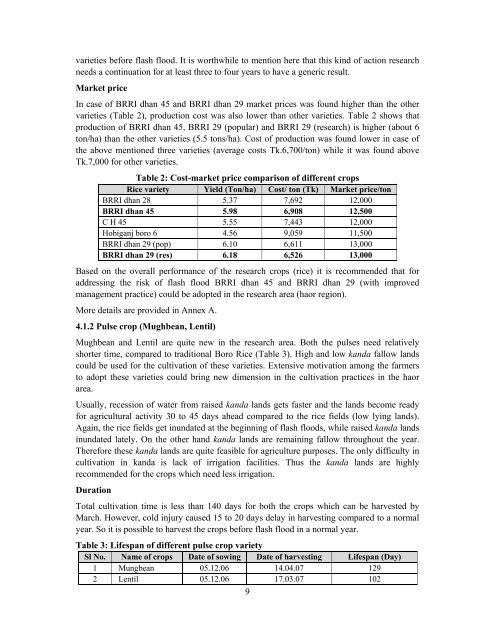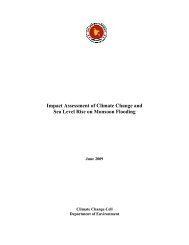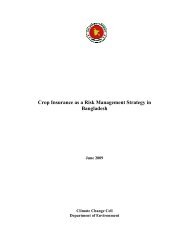Adaptive Crop Agriculture Including Innovative Farming Practices in ...
Adaptive Crop Agriculture Including Innovative Farming Practices in ...
Adaptive Crop Agriculture Including Innovative Farming Practices in ...
You also want an ePaper? Increase the reach of your titles
YUMPU automatically turns print PDFs into web optimized ePapers that Google loves.
varieties before flash flood. It is worthwhile to mention here that this k<strong>in</strong>d of action research<br />
needs a cont<strong>in</strong>uation for at least three to four years to have a generic result.<br />
Market price<br />
In case of BRRI dhan 45 and BRRI dhan 29 market prices was found higher than the other<br />
varieties (Table 2), production cost was also lower than other varieties. Table 2 shows that<br />
production of BRRI dhan 45, BRRI 29 (popular) and BRRI 29 (research) is higher (about 6<br />
ton/ha) than the other varieties (5.5 tons/ha). Cost of production was found lower <strong>in</strong> case of<br />
the above mentioned three varieties (average costs Tk.6,700/ton) while it was found above<br />
Tk.7,000 for other varieties.<br />
Table 2: Cost-market price comparison of different crops<br />
Rice variety Yield (Ton/ha) Cost/ ton (Tk) Market price/ton<br />
BRRI dhan 28 5.37 7,692 12,000<br />
BRRI dhan 45 5.98 6,908 12,500<br />
C H 45 5.55 7,443 12,000<br />
Hobiganj boro 6 4.56 9,059 11,500<br />
BRRI dhan 29 (pop) 6.10 6,611 13,000<br />
BRRI dhan 29 (res) 6.18 6,526 13,000<br />
Based on the overall performance of the research crops (rice) it is recommended that for<br />
address<strong>in</strong>g the risk of flash flood BRRI dhan 45 and BRRI dhan 29 (with improved<br />
management practice) could be adopted <strong>in</strong> the research area (haor region).<br />
More details are provided <strong>in</strong> Annex A.<br />
4.1.2 Pulse crop (Mughbean, Lentil)<br />
Mughbean and Lentil are quite new <strong>in</strong> the research area. Both the pulses need relatively<br />
shorter time, compared to traditional Boro Rice (Table 3). High and low kanda fallow lands<br />
could be used for the cultivation of these varieties. Extensive motivation among the farmers<br />
to adopt these varieties could br<strong>in</strong>g new dimension <strong>in</strong> the cultivation practices <strong>in</strong> the haor<br />
area.<br />
Usually, recession of water from raised kanda lands gets faster and the lands become ready<br />
for agricultural activity 30 to 45 days ahead compared to the rice fields (low ly<strong>in</strong>g lands).<br />
Aga<strong>in</strong>, the rice fields get <strong>in</strong>undated at the beg<strong>in</strong>n<strong>in</strong>g of flash floods, while raised kanda lands<br />
<strong>in</strong>undated lately. On the other hand kanda lands are rema<strong>in</strong><strong>in</strong>g fallow throughout the year.<br />
Therefore these kanda lands are quite feasible for agriculture purposes. The only difficulty <strong>in</strong><br />
cultivation <strong>in</strong> kanda is lack of irrigation facilities. Thus the kanda lands are highly<br />
recommended for the crops which need less irrigation.<br />
Duration<br />
Total cultivation time is less than 140 days for both the crops which can be harvested by<br />
March. However, cold <strong>in</strong>jury caused 15 to 20 days delay <strong>in</strong> harvest<strong>in</strong>g compared to a normal<br />
year. So it is possible to harvest the crops before flash flood <strong>in</strong> a normal year.<br />
Table 3: Lifespan of different pulse crop variety<br />
Sl No. Name of crops Date of sow<strong>in</strong>g Date of harvest<strong>in</strong>g Lifespan (Day)<br />
1 Mungbean 05.12.06 14.04.07 129<br />
2 Lentil 05.12.06 17.03.07 102<br />
9





